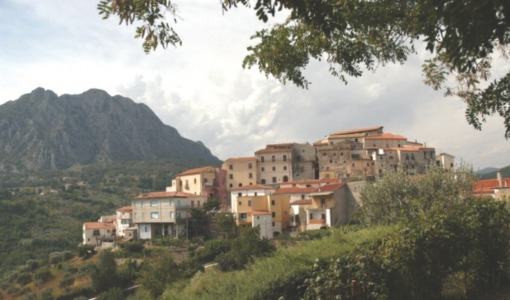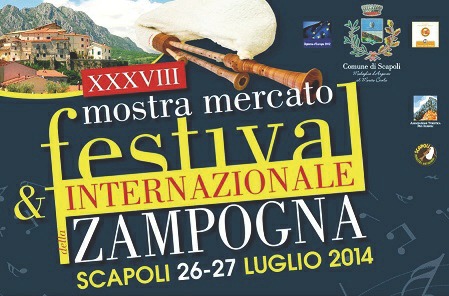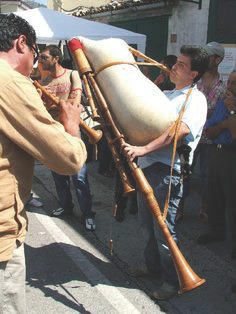The Bagpipe Society
Zampogna - Full Circle part 2 - Completing the Circle
In the second part of my article on zampogna, I will say a little about the process of making one and introduce my contribution to plastic reed technology, the “Parr spine”. Bet you can’t wait. I will also explain the title of the article, “Full Circle”, which will lead us on nicely to the extraordinary experience of the zampogna festival in Scapoli. I’m conscious that there was a slightly hysterical, overwrought tone to Part One and I will try to be a little more sober in Part Two.
Making my first zampogna, I immediately had a bag decision to make. Actual goat, goat- shaped (“capriform”?) or Scapoli? Let me explain.
The tiny village of Scapoli lies nestled in the mountains of the Molise, an agricultural, undeveloped area of central Italy. (I looked hard for other words than “nestled” which is a bit clichéd, but it is in fact the correct term). It is breathtakingly beautiful. Of its 900 inhabitants, no less than 5 are zampogna makers. For many years it has been the centre of the zampogna tradition and Scapoli instruments, as I mentioned in Part One, are characterised by the use of found materials. For at least the last 50 years, the material for making bags has been old lorry inner tubes. The oddness of this has only just this minute struck me. In the UK, lorries are far more common than goats and the mind of the would-be pipe maker may, understandably, turn to their tyres as a source of bag material (some of us remember Dave van Doorn’s wonderful Spacehopper- based pipes). But now I come to think of it, in Scapoli goats are far more common than lorries. Also, Scapoli is approached on a tiny winding road and getting a lorry up it would be quite a feat (though nothing is beyond Italian drivers) and in any case, there’s nowhere to go once you get there. Scapoli isn’t on the way to anywhere else. There is literally no through road. So the use of lorry inner tubes is less obvious than one might think, lorries not being a prominent feature of Scapoli life. However, used they were. More recent Scapoli instruments tend to have Wintex bags, but the shape of the lorry inner tube remains, and so the bag shape is basically just an arc of a circle. Personally I don’t find it very comfortable or visually appealing. The fact that the musical parts of zampogna emerge from the once-breathing skin of a medium-sized ruminant quadruped seems to me to add greatly to its charm and certainly to its visual impact. So not a Scapoli-type bag.

My wife Tracey refused to countenance the idea of an actual goat (mind you, she said the same thing about a stationary engine and I managed to smuggle one of those in, HA!), so goat-shaped it was. Capriform.
Stock next. This took some thinking about. I wanted to have the option of thumb holes in the drone so that other chords than the basic D/G were available. The left hand chanter has no thumb hole, so the left hand thumb is free to open holes on the drone. On the traditional zampogna holes are drilled in the stock on concentric circles, those for the chanters in the horizontal plane at a narrow angle of splay and for the drone in the vertical plane at a slightly greater angle. This makes the drone diverge away from the left chanter which in turn makes it a big stretch to get your thumb across. To resolve this the hole for the drone had to be drilled at a compound angle so that the drone followed the line of the left chanter as far as possible. I thought about various jigs and fittings to do this, then I saw a Youtube clip of an Italian maker drilling the holes by eye with a twist drill on a long rod held in a Black and Decker. Being a naturally low-tech person, I did likewise. It works well; the long steel rod mimics the components and allows one to visualise their spatial relationships with surprising accuracy. The holes were then opened up with a 1:18 tapered reamer made for the purpose.
Zampogna reeds are long and narrow. Styrene (yoghurt pot plastic) is not stiff enough to be usable. My first experiments were therefore with Mylar. This comes in sheet form and has to be curved to give the reed blades their arch (yoghurt pots of course are ready-curved). Allinson’s dried yeast tins have just the right degree of curvature; cut a strip of Mylar, tape it round the tin, pour in boiling water, leave five minutes, empty and add cold water, job done. I said I was low-tech. Using this method, after much trial and error I made a set of workable reeds. Mylar is a difficult material to work. As well as needing to be heat formed, it is difficult to cut accurately. It is impossible to scrape and has to be sanded. Because of its extreme stiffness much force is needed to bind it onto the staples. Although the resulting reeds worked I was not happy with the sound quality which I thought was dull and uninteresting. I remembered a conversation many years ago with Eric Moulder; talking about the relative flabbiness of plastic reeds he half jokingly suggested gluing two thicknesses together. I decided to give it a try. The first set of reeds eventually worked but it took forever to sand/scrape away the surplus plastic. I eventually realised that all that was really needed was a strip of plastic to provide stiffness along the spine of the blades. This could be blended into the tip of the reed by scraping. Compared with Mylar, these reeds are easier to make and sound better. The glue is cyanoacrylate/ superglue. If both surfaces are abraded then it grabs instantly and seems to become one with the plastic of the reed blade. I was worried that the reeds might delaminate but this has not proved to be a problem. So there it is; a 4mm strip of material glued centrally to the reed blade to stiffen it and extend the range of reed designs which can be made from styrene. The Parr spine. You’re very welcome. I had a working zampogna. I decided to take it to Italy.

The Scapoli festival is held on the last weekend of July. It is not the easiest place to get to especially if, like us, you’re on a tight budget. The nearest airport is Naples but flights these are inexplicably more expensive than to other parts of Italy, so much so that it was cheaper to fly to Pisa, rent a car and drive the 330 miles south. We arrived in Scapoli tired but happy – it was very exciting to see all the signs to places which had just been names on a map – Volturno, Rochetta , Campobasso - and parked in the Piazza Martiri, to be met by the irrepressible Antonietta Caccia, founder of the Associazione Culturale “Circolo della Zampogna”, and of the Museo della zampogna, a permanent museum of zampogna and other bagpipes. Antonietta and her husband were incredibly helpful throughout our stay, had found us accommodation and helped translate, my confidence in my linguistic abilities being sadly misplaced.

We arrived some days before the festival was to start, so we had a chance to see Scapoli as it “really” is. This part of Italy is poor. Scapoli seemed to be the most vigorous of the many tiny hilltop villages, several of which were clearly struggling. The youngsters, understandably, have all left for the bright lights and big cities, and so the population of many of these villages is aging and the villages starting to look run down and shabby, with many vacant houses. Also, people from Naples and other large cities drive up into the villages and abandon their unwanted dogs. There was a pack of half a dozen such waifs in Scapoli; I am not a dog person but they were a surprisingly likable and unthreatening bunch, with Oxfam eyes and woolly coats. I manfully suppressed thoughts of the dogbag zampogna – so wrong, so wrong, but…
A large stage was erected in the village square and the afternoon before the festival began, a few traders set up stalls. But the morning of the festival was cold and rainy and I began to resign myself to the whole thing being a bit of an anti-climax. Throughout the morning however more and more people arrived, stalls and food stands were erected and the festival just took off. By late afternoon the village was awash with zampogna and ciaramella players (the latter with faces that you’d never tire of punching), dancers, drummers and a small and slightly sinister group of black-clad “tenore di bitti” singers from Sardinia (they later gave a concert on the main stage which was just electrifying).
I had intended to try to give an extended account of the experience, but I don’t seem to have the words for it. The combination of a lot of zampognas, a lot of Italians and a lot of scenery is quite overwhelming. You can look at various clips on Youtube which will give you a flavour. There is no doubt that there is a straightforward commercial element to the whole enterprise. Comparisons with St Chartier are obvious. Scapoli is making constructive use of (I am deliberately avoiding the term “exploiting”) its musical heritage, and good luck to it. The festival is a great experience and I certainly hope to go again. But the place and the people are a great experience too, and really more important than the two day extravaganza that takes them over once a year.
The bucolic lifestyle with which the zampogna was associated seems to be gone from Scapoli. There are no more shepherds and no more flocks of sheep. The instrument and its tradition survive with unbroken lineage to be sure but, as in France, this part of Italy it is a more self- conscious continuance of a tradition which would otherwise have perished. Further south, in Calabria and in Sicily, the zampogna seems to retain its original relationship with people, their animals and their community. For an account of this, you can’t do better than looking at David Marker’s beautiful documentary “Zampogna - the soul of Southern Italy”. It’s on Youtube, but you can also buy it on DVD, which is better. But do see it.
Full circle – well, there’s something circular about the endless rocking rhythm of the zampogna. And there’s the Circolo della zampogna, the Scapoli based association who campaign tirelessly for the zampogna and its music and tradition and who run the wonderful bagpipe museum. But there’s also the fact that when, back in the late 70’s, Jon Swayne and Blowzabella started the English bagpipe revival, the chanter and reed of Jon’s G pipes were based on a zampogna he owned. I liked the sound of those pipes and so did a lot of other people. They were part of what turned me into an instrument maker. In falling in love with the zampogna and making them, I have come full circle – my enthusiasm for bagpipes started with a zampogna based instrument and has returned to the thing itself.
- Data Processing Notice (GDPR)
-
@BagpipeSociety on X (formally known as Twitter)
-
TheBagpipeSociety on Instagram
-
 BagpipeSociety on Facebook
BagpipeSociety on Facebook
Something wrong or missing from this page? Let us know!
